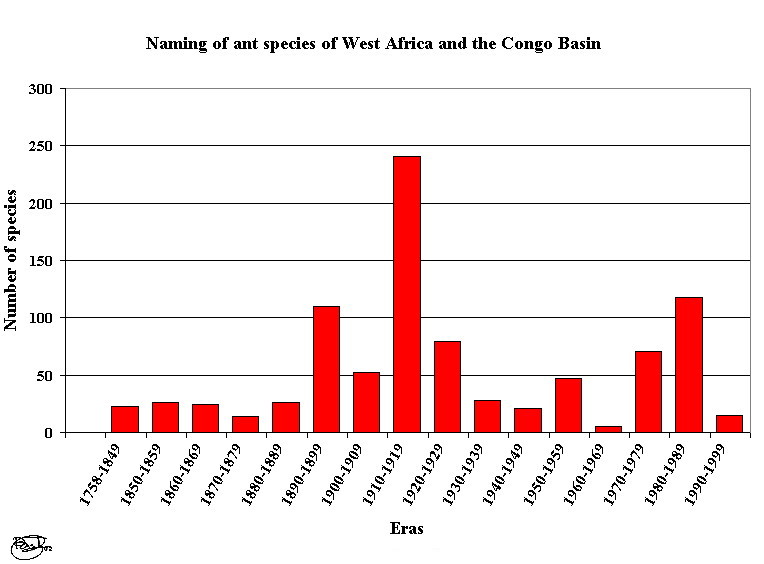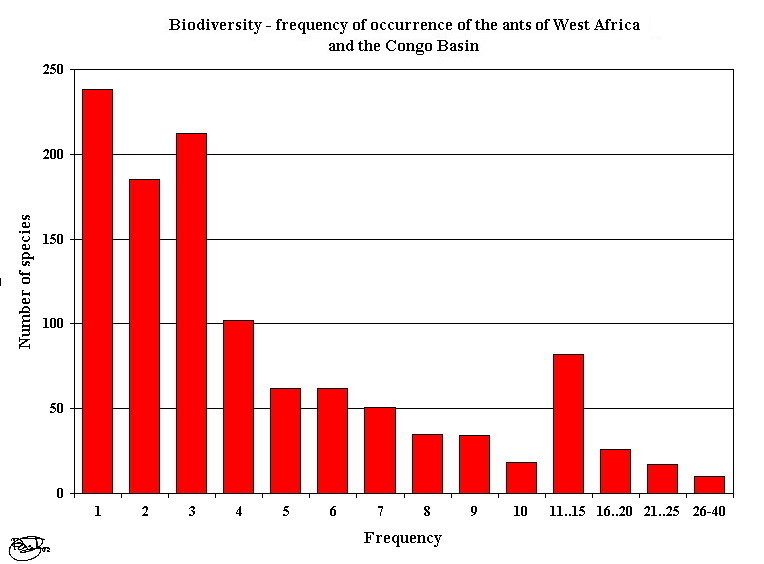Chapter 5 - Biodiversity and Niches
| The Ants of Africa Chapter 5 - Biodiversity and Niches |
Biodiversity, is one of the few science topics to have received significant global, political attention in recent years. Hopefully, governments will demonstrate a real commitment to the maintenance of biodiversity and ecosystems. An unanswered question, however, is how significant or real is the proclaimed loss of species?
In his New General Catalogue of the Ants of the World (Harvard University Press, 1995), Barry Bolton listed 9,536 species (up to 31 December 1993), with an uncounted number of the questionable systematic level of subspecies (Bolton, 1995). These, of course, are not as the writer of the blurb on the back cover of the book would have us believe, "all the ants that are or ever were". They are simply the names which have been published. In many instances the "species" represent duplicate or more names for what a modern, careful revisionary study will show to be single taxa. To counterbalance that fact, however, there are numerous instances in the bionomics literature of specimens, or forms, which have been recognised as separable from described species and have been denoted by code numbers or letters. In the present review, my search has thrown up a total of 902 species and 232 forms from West Africa and the Congo Basin (925 species and 270 forms as at 2003). The new www.Antbase.org world total is some 11,000 plus species.
Modern systematic revisions, most being by Barry Bolton, have dealt with about half the genera of West African ants. In his revision of the Afrotropical Monomorium ants, for instance, he concluded that there were 145 valid species; of those 46 were wholly new, 35 were raised to species from an older subspecies status, and only 64 were previously recognised species (Bolton, 1987). The revision, however, had led to 23 old species being synonymized with other old species. The increase in numbers of species in the revised genera is illustrated by Table 1. The validity of the majority of code-denoted forms has been confirmed by their recognition as new species.
| Genera | Species prior to revision | Species after revision |
| Axinidris | 1 | 10 |
| Cataulacus | 22 | 30 |
| Polyrhachis | 16 | 26 |
| Monomorium | 16 | 26 |
| Serrastruma | 6 | 10 |
| Smithistruma | 4 | 23 |
| Strumigenys | 9 | 21 |
| Tetramorium | 29 | 71 |
Analysis of the species list has also provided an interesting historical picture of the collection and recognition of new taxa over the past 200 years - this is shown in Figure 1.

One conjecture has to be that the activity around the turn of the 20th Century owed much to Imperial rivalry, vividly demonstrated by the proliferation of "species" due to discovery in different colonial realms and identification in competing museums. Hence, the extent of synonymization of species names from that era by modern taxonomists. The surge in species numbers between 1970 and 1990 was largely a spin-off from the economically inspired research on cocoa.
Despite the considerable activity, however, much needs to be done and Table 2 shows the major genera that have not been revised. Sadly, the list includes the genera known to be of the greatest economic importance and shows a failure of the museum taxonomists to meet the needs of their colleagues in economic entomology.
| Genera | No. of defined species | No. of denoted forms |
| Aenictus | 13 | 6 |
| Camponotus | 32 | 8 |
| Crematogaster | 48 | 28 |
| Dorylus | 30 | 6 |
| Hypoponera | 20 | 7 |
| Lepisiota | 4 | 19 |
| Oligomyrmex | 5 | 21 |
| Paratrechina | 6 | 12 |
| Pheidole | 20 | 44 |
| Tapinoma | 1 | 14 |
| Technomyrmex | 5 | 17 |
| Total | 184 | 182 |
When it comes to the pure issue of diversity, Figure 2 reveals the reason for my opening question "how significant or real is the proclaimed loss of species?". By scoring all the species and forms, according to how many records I could find in the taxonomic literature or how much is known from the economic entomology and ecology, an indication was derived as to the rarity or otherwise of a taxon.

The frequency score was derived by allocating values as follows:
1 = known only from the holotype specimen; 2 = known from a single
collection, including the holotype; 3 = known from 2-10 records; 4 =
known from many records or known as widespread from survey work; 5 =
known from economic entomology, etc., to be dominant species.
Scores were given for each of Cameroun, Ghana, Guinea, Ivory Coast and
Nigeria; for a group of all other West African countries; for the Congo
Basin (most of Zaïre, Congo and Gabon); and for a grouping of other
countries of sub-Saharan Africa. These were totalled up to give the
score shown in the histogram, the maximum score being 40.
But is this indication sound?
What for instance, should one make of the fact that 423 species, 37.3%, have been found only once, i.e. score 2 or less. Or that a score of 3 or less, encompassing relatively rare species, is given to 635 species, 56.0% of the total? The IUCN Red List of Ants includes only 151 species - how does that relate to the figures I have here? Are all the 653 rare species from West Africa and the Congo Basin worthy of inclusion in a Red Data Book? If not, why not?
One answer lies in Figure 2. The number of species relates directly to the activity of collectors, followed by taxonomists, of course. Almost without exception the oldest named species are among the larger, showier ants. For instance, the well-known and very obvious Weaver Ant, Oecophylla longinoda, was described by Latreille in 1802. The large, spiny and coloured ants Polyrhachis militaris (Fabricius) and Polyrhachis laboriosa F. Smith date from 1781 and 1858 respectively. With the small, insignificant and sometimes cryptic species which form the vast multitude of ants, however, a specialist collector may discover several new forms from a single sample in a hitherto poorly-investigated habitat. Robert Belshaw, working with Barry Bolton, sampled the leaf litter of the Ghana forest zone in 1991-92, coming up with 197 species from 34 sites, with ten 1m² quadrats at each. Of the species, 74 were either new (identifiable as such from modern revisions) or members of unrevised genera (Belshaw & Bolton, 1994).
A second more profound answer lies in the proliferation of niches or microhabitats which can be exploited by ants. A good example is shown by ants of the genera Serrastruma and Strumigenys which are specialist feeders on Collembola of rain forest. Not only do the ants have highly developed, elongated mouthparts to seize their prey but also they are known to produce chemical attractants to lure them (Dejean, 1985). The vulnerability of the soft-bodied Collembola to desiccation, however, means that even in rain forests they congregate in damp patches of leaf litter, especially in the dry season. The obvious consequence is that the ants also are restricted to such patches. The end-result seems to be speciation in much the same manner as is well-known in island biogeography.
As already considered (in the Mosaics conclusions), other equally significant but less obvious niches may well prove to be due to the phenomenon of dominance, well established in cocoa farms, where some five or six ant species each control territories of perhaps as many as 100 trees. Within those territories a number of other, often smaller, species are able to co-habit. Each dominant, however, has a limited number of such consorts and both positive and negative associations have been established between dominants and consorts (Taylor, 1977). Interestingly, there are species which appear able to reside on trees no matter which dominant is present. These seem to survive by being discreet, unthreatening, non-competitive when it comes to food resources, or by simply being evasive and quick on their feet. Although the pattern of dominants, or the ant mosaic, is quite well studied on cocoa, little is known about it on other tree crops and even less about the situation on forest trees. What may well be true, however, is that forest clearance and replacement by tree crops does not lead to a great depletion of natural diversity.
Although not much is known about territoriality and competition when it comes to ants of the soil surface, and almost nothing is known of the sub-surface, a realm where clearly more than a few species spend all their time, it again seems likely that tree crops do not over-affect diversity. Indeed there often is more habitat diversity in the commonest form of tree-cropping in Africa - the permaculture, with intermingled tree and field crops, plus a greater amount of lightly shaded or unshaded ground, a requirement for many ants with possible savannah origins (Dejean et al., 1986).
The true question to which we presently have no answers is:
"Does apparent rarity (the 56 % of ants which have been encountered on no more than a few occasions) mean anything more than that we haven't looked hard enough or systematically enough?"
After all, although small damp patches may confine the Collembola hunters we know nothing of the real abundance of those patches.
So my answer to the opening question is - "We really don't know". For sure, we must be concerned to preserve a diversity of habitats but we must not simply assume that virgin primary forest is all that will provide such diversity.
Further consideration can be found in the sub-Chapters Ant Ecology in Guinea, More on Niches (which includes a synthesis of the mosaic on cocoa farms) and Examples of Diverse Habitats.
|
©1998-99, 2002, 2003 - Brian Taylor CBiol FSB FRES 11, Grazingfield, Wilford, Nottingham, NG11 7FN, U.K. |
href="diverse1.htm"